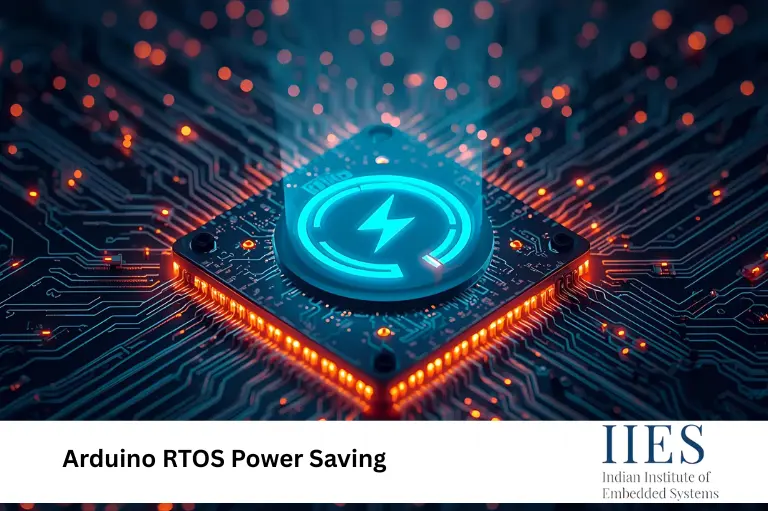
Arduino Power Management is essential for creating efficient, battery-powered devices. By using sleep modes, peripheral control, and FreeRTOS scheduling, developers can cut power use, extend battery life, and design smarter IoT, wearable, and embedded systems without losing performance.
Mastering Arduino power management in RTOS environments gives you the knowledge to apply techniques like tickless idle, dynamic frequency scaling, and interrupt-driven wakeups, ensuring your embedded projects are both performance-driven and energy-efficient.
Arduino power management means reducing energy consumption in microcontroller-based systems. This can be achieved by:
Efficient Arduino RTOS power management helps:
At the hardware level, Arduino boards provide several built-in features to minimize energy consumption. By using microcontroller sleep modes and controlling peripherals, developers can achieve significant power savings in embedded projects.
Most Arduino boards (AVR, ARM Cortex-M) support several sleep states:
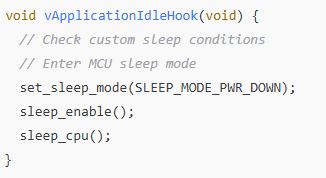
Shutting down unused modules like UART, I2C, or SPI reduces energy use. On AVR boards, this can be done through the Power Reduction Register (PRR).
Efficient power management in an Arduino RTOS environment requires a mix of hardware features and smart scheduling. Below are key strategies that help extend battery life, optimize performance, and maintain reliability in real-time applications.
Normally, FreeRTOS uses periodic system ticks. With Tickless Idle, the MCU sleeps until the next scheduled task.
![]()
You can define your own logic inside vApplicationIdleHook() to put the MCU in deep sleep whenever all tasks are idle.
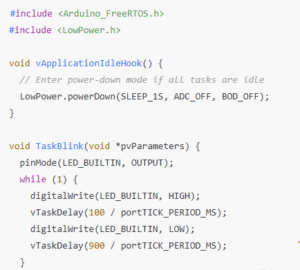
Instead of polling sensors, use Arduino interrupts to wake the MCU only when needed.
![]()
![]()
Libraries like LowPower.h (AVR) or Arduino Low Power (SAMD) simplify entering sleep states and disabling modules.
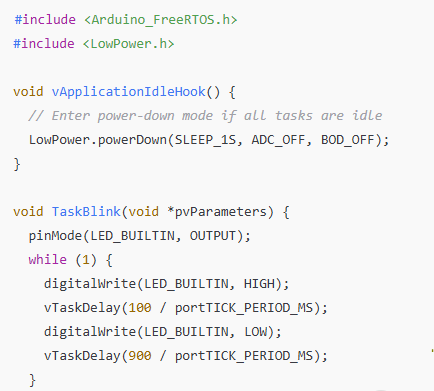
On ARM boards, reduce the clock frequency when performance is not critical. On AVR, adjust the system clock prescaler for lower energy use.
Instead of polling, configure Arduino interrupts to wake the CPU from deep sleep.

You can also send data safely from interrupts to RTOS tasks using queues:

Group tasks like sensor reading + logging into one job.
Here’s a quick comparison of techniques and their RTOS integration:
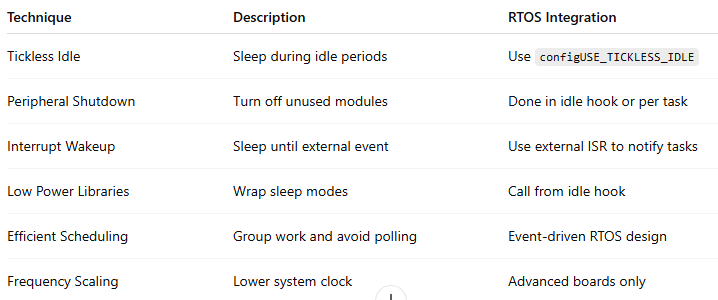
By combining tickless idle, sleep modes, interrupt wakeups, and low-power libraries, you can significantly improve Arduino power saving in FreeRTOS projects. These strategies make your designs battery-friendly, efficient, and scalable for real-world IoT and embedded systems.
They are hardware states (Idle, Power-Save, Power-Down, Standby) that reduce consumption by disabling parts of the MCU.
It offers features like Tickless Idle and Idle Hook, which let the MCU sleep safely when tasks are inactive.
Yes, interrupts allow the MCU to stay in deep sleep until triggered by an external event, making them essential for power saving.
Boards like Arduino Pro Mini (3.3V/8MHz), MKR series, and ARM Cortex-M-based boards are widely used
Use sleep modes, disable unused peripherals, and apply event-driven design instead of polling.
Yes, FreeRTOS supports tickless idle and idle hooks, enabling safe transitions into sleep states.
Indian Institute of Embedded Systems – IIES